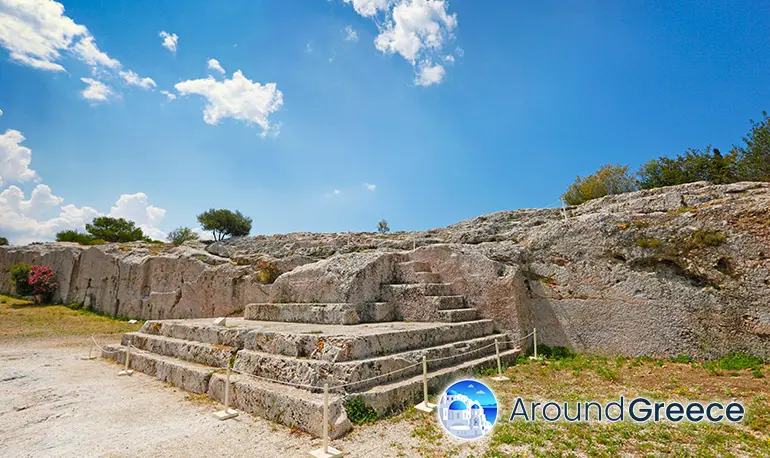A Historic Location for Democracy
The Pnyx is a small hill located approximately 1km to the west of the entrance and exit of the Acropolis. Though it is relatively unspectacular in comparison with other sites in Athens, it's history made it one of the most significant in, not just Athens, but the whole world.

The Pnyx was the place of meeting for the world's first democratic legislature. The hill of the Pnyx is a semicircular shape, and was ideal as a terrace from which to address the crowds that gathered regulary. The Ekklesia (meaning the gathering of crowds) was held here from the 6th to the 4th Centuries BC.
During these democratic meetings, laws were discussed, and propositions brought forward, with the citizens, who each had the right to speak. Though all citizens were deemed equal, with the equal right to speak, it was mainly the leaders who dominated the proceedings. There was also a rule that citizens over the age of 50 had the right to be heard before others.
After a brief pause of the meeting at the Pnyx, due to Athens defeat to Sparta in the Peloponnese War, they were again resumed when power was seized by the democrats. The meetings then continued to be held, in some cases over 40 times a year, until 338 BC, when Athens lost it's independence to Philip II of Macedonia.
When these meeting took place, there had to be a quota of 5000. Historical figures of Athens at the time, such as Pericles and Aristides would almost have certainly spoke here. However, slowly over time, the figures of attendance started to drop, and many times, people were actually forced to take part in the gatherings.

At its peak, the area where these meetings would have taken place would have looked slightly different than to what we see there today. The bema, which was the stone platform on which the speakers would stand to address the crowd, would have had in front, bare rock, on which the crowd would have stood. Today, this has become a grassy area. There would also have been rows of wooden seats, on which the members of the council would have sat on. In later times, there would have been two covered galleries, which where built to protect the council members from both the sun and rain.
After excavations, there were some interesting finds discovered. Foundations of several important buildings on the Pnyx were discovered. It is said that the majority of these buildings and structures were actually built on the Pnyx, after it had lost its importance. Though today there are little remains of this once historic hill, it is still worth visiting, as one can only imagine the scene here all those years ago. The views from here are very impressive, with the Parthenon looking down upon the site.
During the summer season, the Pnyx is the venue for the “Light and Sound” show, which takes place daily. This show tells the story of the Acropolis, and with it's beautiful lighting and sounds, can be a very interesting evening, especially to those interested in the Acropolis story.
Map of the Pnyx Hill
Below you will find a map which shows the location of the Pnyx Hill in Athens. Click on the map image below to load the Google map.
Visitor Information
Opening Hours:
The Pnyx is always open, though visiting during daylight is recommended.
Entrance Fee / Prices:
No Admission fee
Location:
The Pnyx is located just a few hundred meters to the west of the entrance to the Acropolis.
Top Sights in Athens
- Ancient Agora
- Areopagus (Hill of Ares)
- Athenian Trilogy
- Filopappou Hill
- First Cemetery of Athens
- Hadrian's Arch
- Hadrian's Library
- Hill of the Nymphs
- Kerameikos Cemetery
- Lycabettus Hill
- Lysicrates Monument
- National Gardens
- Panathenaic Stadium
- Pnyx
- Roman Agora
- Syntagma Square
- Temple of Olympian Zeus
- Tower of the Winds
- Zappeion
